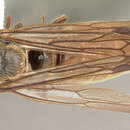en
names in breadcrumbs


Figures 47, 112, 123, 137, 148
Neivamyrmex texanus Watkins , 1972: 353 (w, q, m). U. S. A. , Texas, Travis Co. , Austin ( USNM ) .
DISTRIBUTION (Map 12)
UNITED STATES: Virginia to Florida, west to Colorado and Arizona; MEXICO: San Luis Potosi to Hidalgo and Jalisco.
SPECIMENS EXAMINED (U. S. A.)
In addition to numerous paratypes, we have 34 records from various states.
DISCUSSION
Small workers may be difficult to distinguish from those of N. nigrescens , but larger workers are fairly easy to distinguish with a little practice. Males may be readily recognized by the distinctive shape of the paramere.
This is a widespread ant, found in many different types of habitat. Although not commonly seen, N. texanus is a large (for Neivamyrmex ) and conspicuous ant when it is actively foraging. Immigration columns are prominent and may often be seen from some distance away when crossing a suitable background. One observed near Tucson stretched well over 100 yards across the desert and could be readily seen as it meandered across the light colored sand. The blind snake, Leptotyphlops dulcius, was observed in the column. Occasionally, when an ant displayed an interest in the snake, it was quickly flicked off (pers. obs., GCS).
Plsek et al. (1969) observed Helluomorphoides texanus (LeConte) in raiding columns of N. texanus and reported their observations on behavior of this species in the laboratory.
Automontage images of the worker are available at antweb. org.